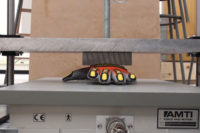Abrasion resistance ratings are often used to evaluate the durability of a glove — that is, how long a glove will last in the field, when used for a variety of tasks. This is a key metric, because glove durability directly affects the overall cost of hand protection programs. The math is simple and effective: a $30 glove that lasts 6 weeks is three times as cost effective as a $15 glove that lasts one week.
This is a more complex issue than you might think. In today’s era of performance work gloves, safety professionals are under increasing pressure to provide high dexterity gloves to employees, but at a low cost that satisfies purchasing constraints. While there is a temptation to move downstream in price, the reality is that a glove designed to maximize durability might cost twice as much as what you are purchasing today, but could reduce your overall hand safety costs by more than 50 percent. This glove could also protect and perform significantly better for your employee’s particular tasks.
Evaluating abrasion resistance
To evaluate durability, many professionals rely on abrasion resistance ratings. Several tests exist that evaluate abrasion resistance. These are the two most common tests:
ANSI 105-2011 is an American standard in which gloves are assigned a rating of 0-6, based on results from the ASTM D3389-10 abrasion testing standard, which is optimized for testing coated fabrics. This test utilizes a Taber abrasion machine, and the testing endpoint is when the fabric coating is worn through, or when the first yarn of knitted fabric is broken. Accordingly, this test is not well suited for gloves with multiple palm layers, gloves that don’t have a coated palm, or gloves that utilize leather or synthetic leather palms.
EN 388-2003 is the European standard that has been adopted by many countries worldwide. Gloves are assigned a rating of 0-5 based on results from the ISO 12947-1 abrasion testing standard. This test utilizes a Martindale abrasion machine, and the testing endpoint is when there is a hole in the palm fabric. The standard states that only fabrics that maintain complete palm, finger and thumb coverage are tested. If there are multiple fabrics, each one is tested separately and results added together. If a fabric only covers a portion of the palm, it is removed and not included in test results. Thus, the weakest point defines the test results.
These tests are suitable for basic glove evaluation; however, they have inherent limitations and several problems may arise when solely using abrasion resistance ratings to determine overall glove durability.
- Most performance work gloves promoted as ‘high abrasion resistance’ have reinforcements in several locations — fingers, palm, saddle and thumb. This will result in higher abrasion resistance in the reinforced areas, but keep in mind that reinforcement layers typically have exposed edges, and edges often fail before the fabric fails. Reinforcement layers also have exposed stitching, which will most likely fail before the reinforcement fabric fails, especially if the stitching ‘rides high’ on the surface of the fabric.
- Finger fourchettes (finger sidewalls) are not part of the standardized abrasion tests. Some gloves are constructed with low durability fourchette fabric, which will lead to early glove failure.
- Stitch strength, stitching abrasion and seam strength are not tested. Many early glove failures are due to seam and stitch failures.
- Some gloves are constructed with a patchwork of multiple pieces of fabric that comprise a single palm layer. This results in an exposed seam on the palm. A failure at the seam would result in an open hole directly on the palm. Even if the fabric rated high on an abrasion test, a seam or stitch failure would result in very poor glove durability.
- Finally, standardized abrasion tests don’t account for the variety of tasks that require higher durability in specific wear areas of the glove.
The bottom line
A glove rated for high abrasion resistance could potentially have low durability when worn by your employees, based on their particular tasks and trades. So what is the best way to determine true glove durability? Meet with a glove expert and evaluate your current hand safety program:
- First evaluate your current hand safety costs; divide the cost of your current gloves by the average lifespan of the glove, in weeks. This equals the average hand safety cost per employee per week. You can multiply by the total number of employees to get your total per week cost.
- Evaluate the tasks your employees are doing every day. Ask employees what they like and don’t like about their existing gloves.
- Evaluate the wear areas and failure points on your current gloves.
- Then set goals for a new hand safety program:
- Increased lifespan of a new glove
- Reduced hand safety cost per employee
- Overall savings of moving to a new glove program
- Improved protection, comfort, dexterity and tactility of a new glove
Based on recommendations from the glove expert, begin testing high performance gloves that could meet or exceed your stated goals. If existing glove models don’t meet these goals, work together with the glove expert to design a new, custom-built glove that will meet them. Involve employees in the information process.
Test the new gloves. Have employees wear the gloves for the duration of the expected glove lifetime. After the test, employees should fill out a simple questionnaire, one that evaluates the gloves both qualitatively and quantitatively. Your glove expert should provide the questionnaire. He or she should inspect the gloves after the test, evaluate their effectiveness, and make modifications if necessary.
At the end of this process, you will have a new glove specific to the needs of your employees — one that will last longer, perform better, and lower the overall cost of your hand safety program.



